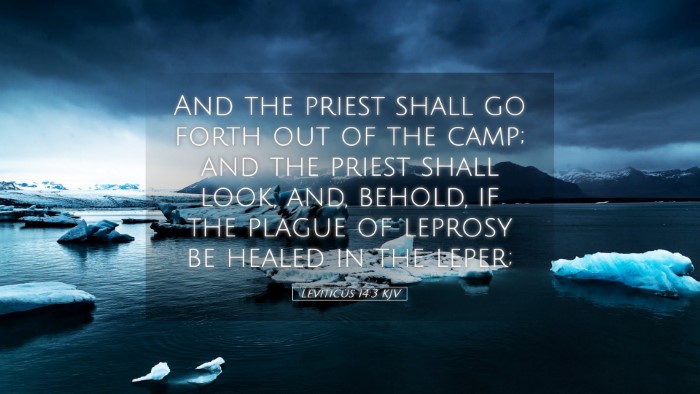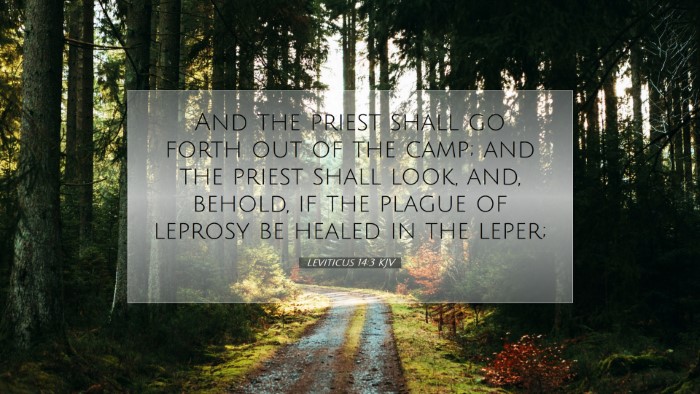Commentary on Leviticus 14:3
Verse Context: Leviticus 14:3 reads: "And the priest shall go forth out of the camp; and the priest shall look, and, behold, if the plague of leprosy be healed in the leper."
Introduction
The journey through Leviticus reveals the unique relationship between God and the Israelites, focusing on purity, holiness, and the regulations governing the community. Chapter 14 marks a significant section concerning the cleansing of lepers, emphasizing the necessity of physical and spiritual restoration. This verse serves as a critical entry point into understanding the rigorous protocols established for those afflicted by leprosy—a metaphor for sin and its consequences.
Insights from Commentators
Matthew Henry
Matthew Henry emphasizes the role of the priest as a mediating figure in the process of healing and restoration. He comments on the importance of the priestly examination, highlighting that the priest would venture outside the camp, indicating God's separation from impurity until restoration is confirmed.
Henry notes, “The priest must go forth, implying that disease had rendered the leper unclean and socially isolated; only upon evidence of healing could the leper be restored to the community." The act signifies a broader theological implication that one must first confront their condition before experiencing healing and readmission. This becomes a powerful type foreshadowing the redemption found in Christ.
Albert Barnes
Albert Barnes' commentary elaborates on the requirement of the priest's inspection as being necessary for re-entry into the community, reflecting God's orderly system of restoration. He explains that the phrase, “the plague of leprosy be healed,” points to a complete transformation—both physical and spiritual. Barnes underscores the leper's need for an understanding of their healing, which can serve as a parallel to believers recognizing their salvation in Christ.
He further explains, “The priest’s role is not just to observe but to declare the leper clean, echoing the authority given to the church in the New Testament to pronounce forgiveness.” This brings awareness to the communal aspect of healing; the restoration of one person restores wholeness to the entire community.
Adam Clarke
Adam Clarke provides a detailed exegesis of the terms used within this verse. He defines “the plague of leprosy” not only as a physical ailment but also as a symbol for moral and spiritual decay. Clarke asserts that the priest's scrutiny is more than just a health check—it is spiritual discernment reflecting God’s pursuit of holiness among His people.
He notes, “The healing of leprosy requires an examination not just of the body but of the heart; it is an invitation to repentance and renewal." Clarke highlights how this examination also reflects God’s desire for integrity and authenticity within His community.
Theological Implications
The significance of Leviticus 14:3 extends beyond its immediate context, offering rich theological implications for pastors, students, and theologians alike.
- Symbolism of the Leper: The leper represents those estranged from God due to sin. The act of the priest examining the leper underscores the truth that healing—and thus communion with God—requires acknowledgment of one’s sinful state.
- The Role of the Priest: In the Old Testament, the priest functioned as an intermediary. In the New Testament, Christ serves this role, fulfilling and surpassing the ancient covenant with a new creation through His sacrifice.
- Community Restoration: The process of declaring a leper clean denotes the communal aspect of salvation. The church is called to aid in the restoration of individuals, helping them find their place within the body of Christ.
- God’s Holiness: The care taken in the procedures highlights God’s unwavering commitment to holiness. It reminds believers that while grace abounds, it does not nullify the necessity for purity in the lives of His people.
Practical Applications
For pastors and church leaders, this verse challenges the church to foster an atmosphere of healing and restoration. Here are a few practical takeaways:
- Encouragement of Confession: Just as the leper was required to bring evidence of healing, so Christian communities should encourage the confession of sins leading to genuine restoration.
- Building a Restorative Community: Churches should create environments that emphasize the healing power of prayer, community support, and counseling, akin to the priest’s role.
- Educational Focus on Holiness: Pastors can underscore the importance of holiness and the ramifications of sin, helping congregants understand the need for repentance and transformation.
- Celebration of Redemption: Finally, churches should celebrate those who return to faith, embodying the joy of restoration illustrated in this passage.
Conclusion
Leviticus 14:3 encapsulates profound truths about healing, community, and the nature of God’s holiness. Insights drawn from the commentaries of Matthew Henry, Albert Barnes, and Adam Clarke collectively enrich our understanding of the transformative power of God’s grace available to all. As we reflect on this verse, may we engage in both personal and communal pursuits of purity, restoration, and deeper fellowship with our Creator.


